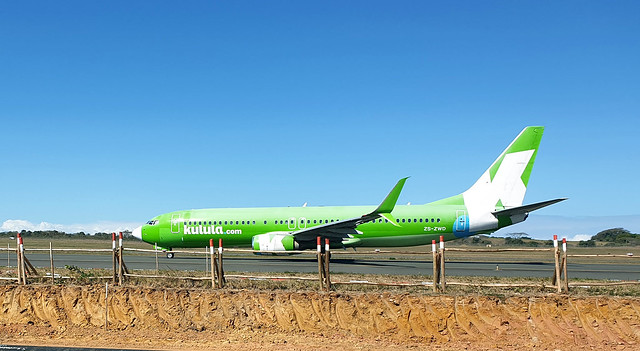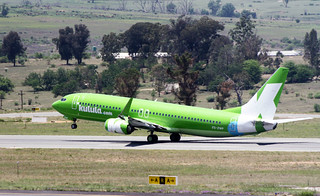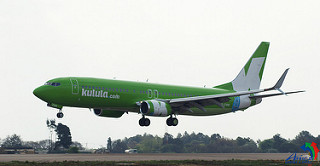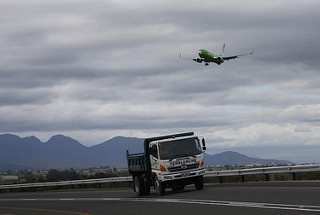Kulula B738 at Cape Town on Feb 27th 2013, rejected takeoff
Last Update: May 27, 2015 / 17:15:00 GMT/Zulu time
Incident Facts
Date of incident
Feb 27, 2013
Classification
Incident
Cause
Rejected takeoff
Airline
Kulula
Flight number
MN-104
Departure
Cape Town, South Africa
Destination
Johannesburg, South Africa
Aircraft Registration
ZS-ZWP
Aircraft Type
Boeing 737-800
ICAO Type Designator
B738
The runway was temporarily closed for a runway inspection and sweeping to clean the debris, mainly separated turbine blades.
The airline confirmed the aircraft rejected the takeoff at low speed due to an engine failure, the engine was shut down and the aircraft returned to the apron. Something flew into the engine resulting in the failure.
South Africa's CAA reported in their list of February incidents released on Mar 26th 2013, that the right hand engine failed, the aircraft rejected takeoff and returned to the apron on the left hand engine.
ZS-ZWP resumed service on Mar 3rd 2013.
On May 27th 2015 South Africa's Civil Aviation Authority (SACAA) released their final report concluding the probable cause of the incident was:
Aborted take-off as a result of the No. 2 engine failure due to the failure of the HPT blade.
Contributory factor
Failure of the HPT blade coating resulting on a corrosion and a subsequent failure of the blades
The aircraft was accelerating for takeoff on Cape Town's runway 01 when at about 30 knots a loud bang was heard followed by vibrations, the right hand engine's N1 and N2 instruments rapidly spooled down to zero and the crew rejected takeoff within 50 meters. Tower activated the crash alarm, two fire vehicles responded to the aircraft and found engine debris on a substantial area of the runway surface.
The crew completed the "engine severe damage memory items" checklist and taxied the aircraft to the apron.
A post event examination of the right hand engine revealed "excessive" damage to the engine including deformations of the engine casing, the engine parts had been contained however. There was extensive turbine blade damage visible from the tail pipe. Further examination showed the forward sump scavenge strainer plug was found contaminated with composite material from the high pressure turbine seal. Loose studs with the nuts still attached were found inside the engine at the bottom of the casing.
The flight data recorder had not recorded any anomaly prior to the event.
The engine was shipped for examination by the manufacturer, a boroscopic inspection there identified three high pressure turbine blades had liberated below their platforms. The CAA analysed: "Fracture surface analysis of under-platform separated blades revealed that the primary fatigue crack initiation occurred via multiple origins from the internal surface located within the cavity. The analysis also showed evidence of secondary fatigue crack initiation on the internal surface of the cavity. Heavy oxidation was observed on the crack surface and most of the blade fracture surface showed characteristics of tensile overload as a result of secondary impact damage."
Incident Facts
Date of incident
Feb 27, 2013
Classification
Incident
Cause
Rejected takeoff
Airline
Kulula
Flight number
MN-104
Departure
Cape Town, South Africa
Destination
Johannesburg, South Africa
Aircraft Registration
ZS-ZWP
Aircraft Type
Boeing 737-800
ICAO Type Designator
B738
This article is published under license from Avherald.com. © of text by Avherald.com.
Article source
You can read 2 more free articles without a subscription.
Subscribe now and continue reading without any limits!
Read unlimited articles and receive our daily update briefing. Gain better insights into what is happening in commercial aviation safety.
Send tip
Support AeroInside by sending a small tip amount.
Related articles
Kulula B738 near Johannesburg on Mar 7th 2022, engine shut down in flight, contained failure
A Kululu Boeing 737-800, registration ZS-ZWB performing flight MN-451 from Lanseria to Cape Town (South Africa) with 135 passengers and 6 crew, was…
Kulula B738 near Johannesburg on Feb 10th 2022, engine shut down in flight
A Kulula Boeing 737-800, registration ZS-ZWD performing flight MN-451 from Lanseria to Cape Town (South Africa), was climbing through about FL260 out…
Kulula B738 at Lanseria on Feb 8th 2022, aircraft continued approach despite TCAS Resolution Advisory
A Kulula Boeing 737-800, registration ZS-ZWF performing flight MN-500 from Durban to Lanseria (South Africa) with 108 passengers and 6 crew, was on a…
Kulula B738 at Cape Town on Jun 7th 2017, turbulence injures passenger
A Kulula Boeing 737-800, registration ZS-ZWB performing flight MN-111 from Johannesburg to Cape Town (South Africa), was on approach to Cape Town in…
Kulula B738 at Lanseria on Nov 9th 2016, engine shut down in flight
A Kulula Boeing 737-800, registration ZS-ZWQ performing flight MN-493 from Lanseria to Cape Town (South Africa), was climbing out of Lanseria when…
Newest articles
Transair Senegal B733 at Dakar on May 9th 2024, runway excursion on takeoff
A Transair Senegal Boeing 737-300, registration 6V-AJE performing flight R2-3043 from Dakar (Senegal) to Bamako (Mali) with 73 people on board, was…
Link SF34 at Canberra on Nov 10th 2022, propeller strap penetrates cabin in flight
A Link Airways Saab 340B on behalf of Virgin Australia, registration VH-VEQ performing flight VA-633 from Canberra,AC to Sydney,NS (Australia), was…
Subscribe today
Are you researching aviation incidents? Get access to AeroInside Insights, unlimited read access and receive the daily newsletter.
Pick your plan and subscribePartner

A new way to document and demonstrate airworthiness compliance and aircraft value. Find out more.

ELITE Simulation Solutions is a leading global provider of Flight Simulation Training Devices, IFR training software as well as flight controls and related services. Find out more.

Your regulation partner, specialists in aviation safety and compliance; providing training, auditing, and consultancy services. Find out more.
AeroInside Blog
Popular aircraft
Airbus A320Boeing 737-800
Boeing 737-800 MAX
Popular airlines
American AirlinesUnited
Delta
Air Canada
Lufthansa
British Airways




